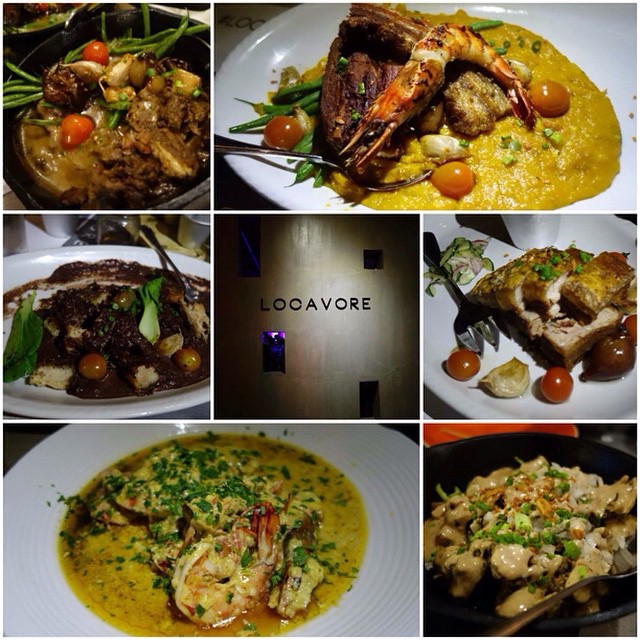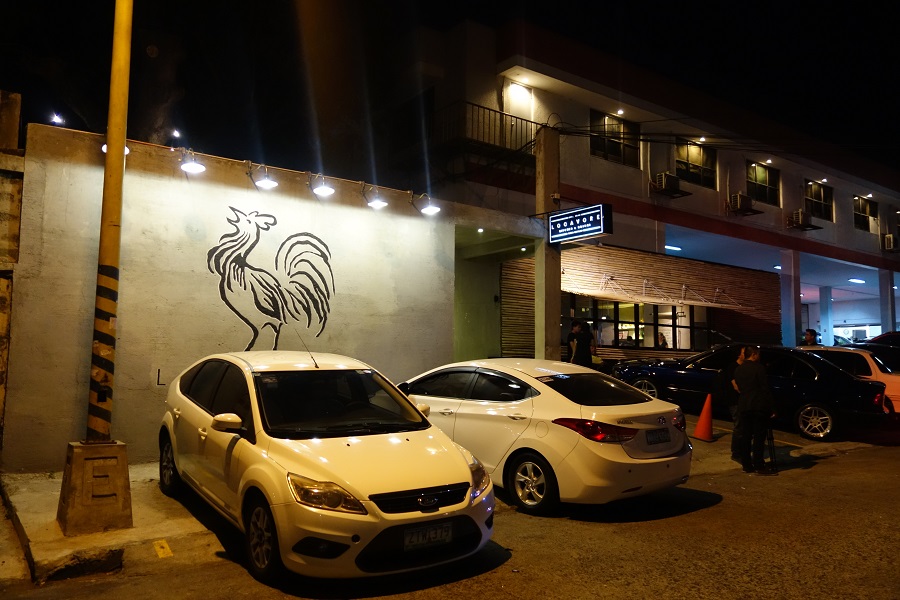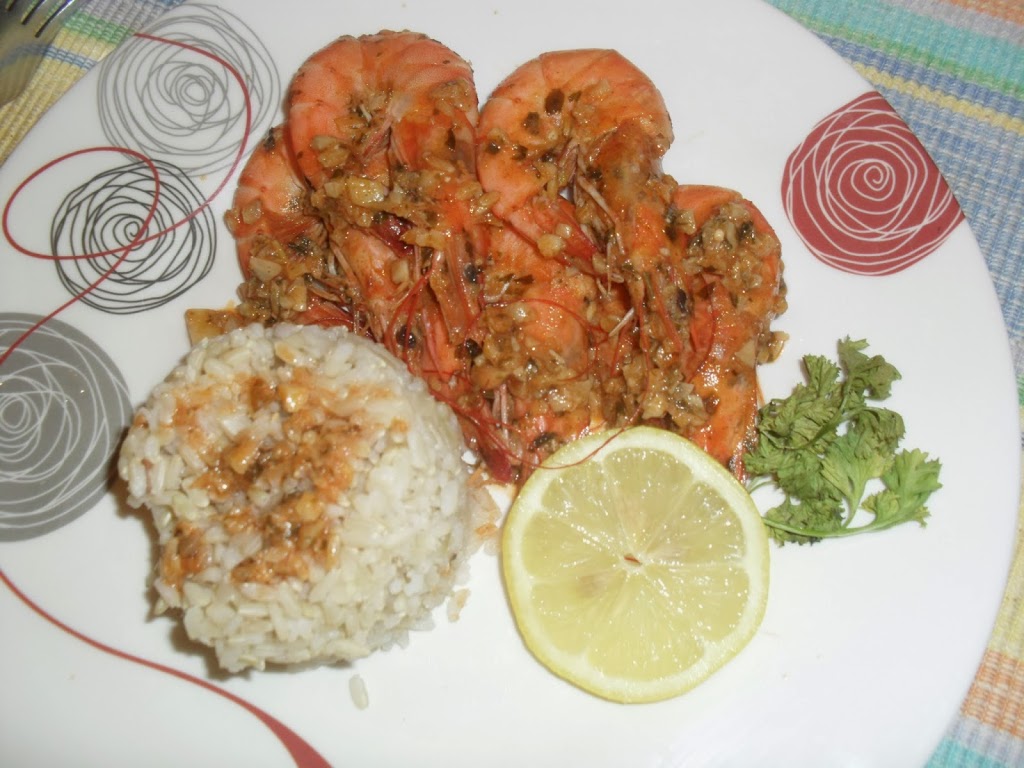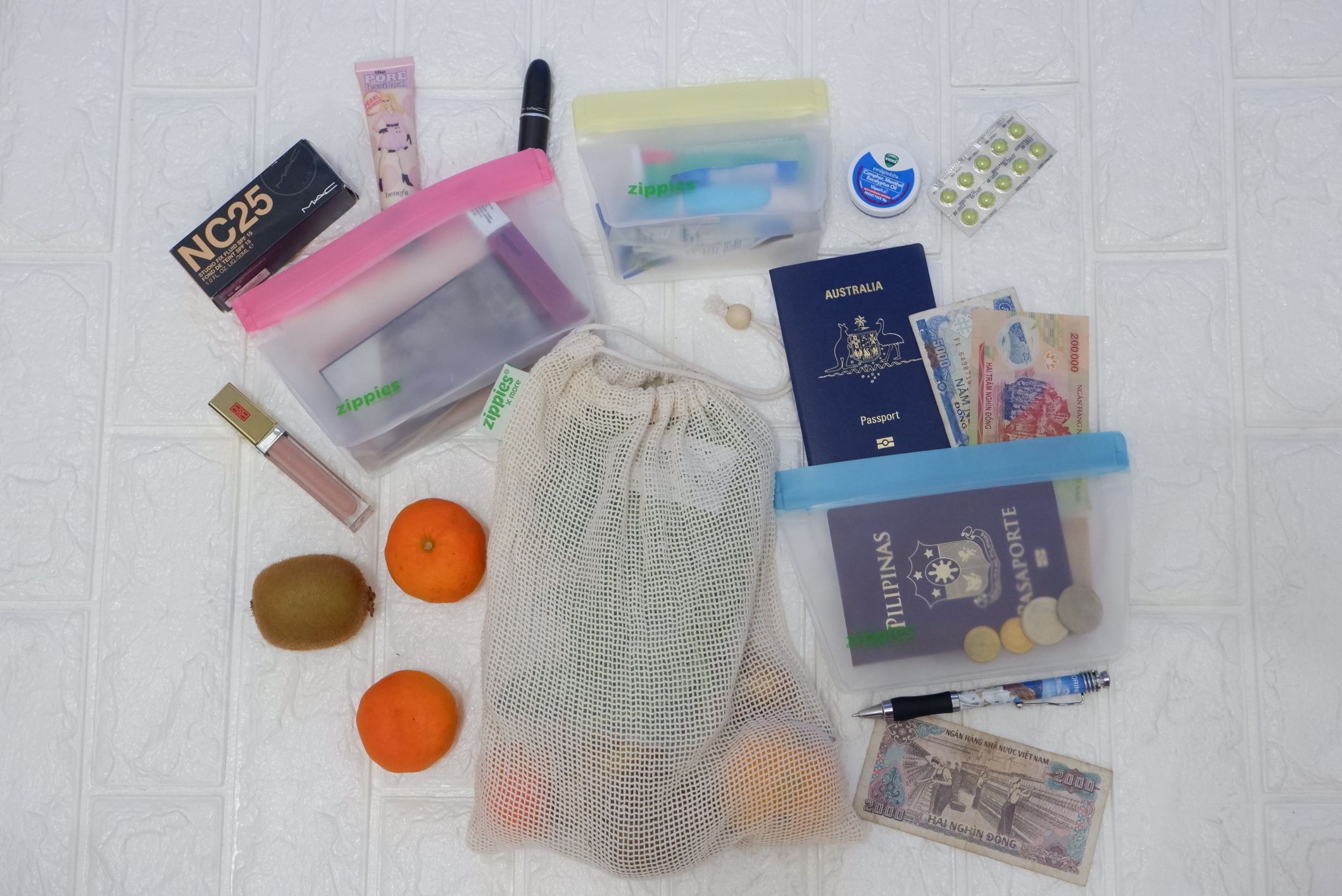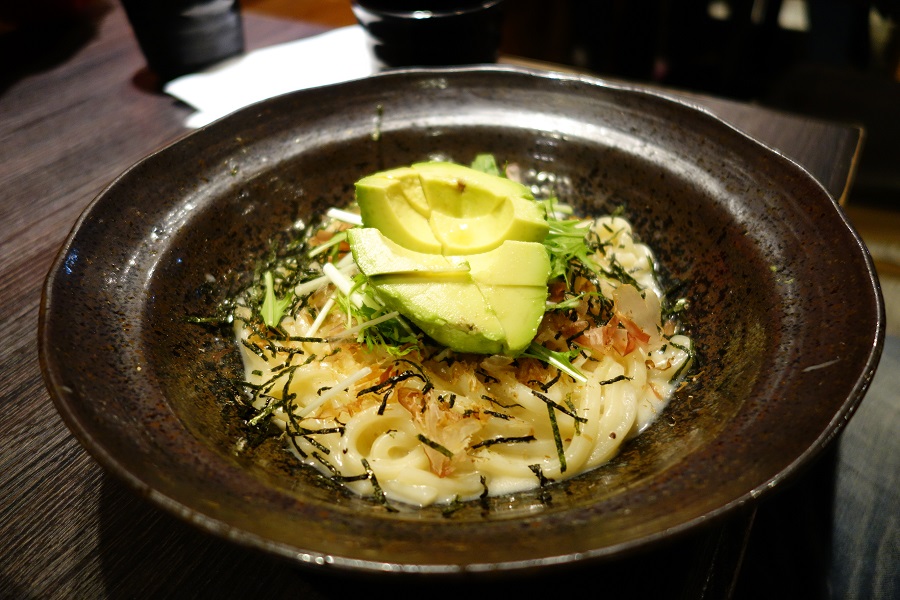Sometimes, it’s the simplest things that surprise you, like a common dish made uncommonly excellent.
Located in Kapitolyo, a residential village turned foodie haven in Pasig, Locavore is a Filipino restaurant and gastropub that’s definitely full of pleasant surprises. They take your grandma’s made-from-scratch recipes and give it a dash of personality and creativity, and cook up something that makes their customers go, “How did they think of that?!”
A “locavore” is a person who eats food that is locally produced. Ideally, the locavore’s definition of “local” would be anything within a hundred mile radius. The locavore movement is prevalent in the United States, and is also practiced in other parts of the world, such as Australia and Canada. The goals for this movements are to support the small purveyors of farming, as well as to lessen carbon footprints. Basically, it means that buying local means you lessen the food miles or the distance the food travels, and this can lead to the reduction of carbon dioxide emissions.
In the Philippines, it’s a little impossible to practice the locavore lifestyle in its truest sense, so the guys at Locavore define it in a different way. They combined the words “local” (because they specialize in Filipino food) + “carnivore” (which means “meat eater,” and their menu is rich is meat dishes).
Their head chef, Chef Mikel Zaguirre (or “Chef Kel”) may have come from a French restaurant, and may have been trained by a Michelin-rated French chef, but Locavore is proudly Filipino. Chef Kel explains:
We source all of our ingredients within the Philippines. For instance, the seafood is from Visayas and Kalibo, the meat is from Batangas, and the vegetables, which are 80% organic, are from Antipolo and Tagaytay. We support Filipino meat products and other small start-up business. Take the beer — it’s locally brewed here in the Philippines. If you’ve seen our tabletop condiments, you’ll see that we use local brands like Datu Puti and Mother’s Best. We want to put it out there that just because it’s Filipino, it doesn’t mean that the content is inferior.

The food is anything but inferior! The most obvious sign that a restaurant is outstanding is when it is always full — even on a weeknight! I have been here thrice, all on a weeknight, and in all those times, the place was full of customers. Imagine how crazy it must be on weekends!
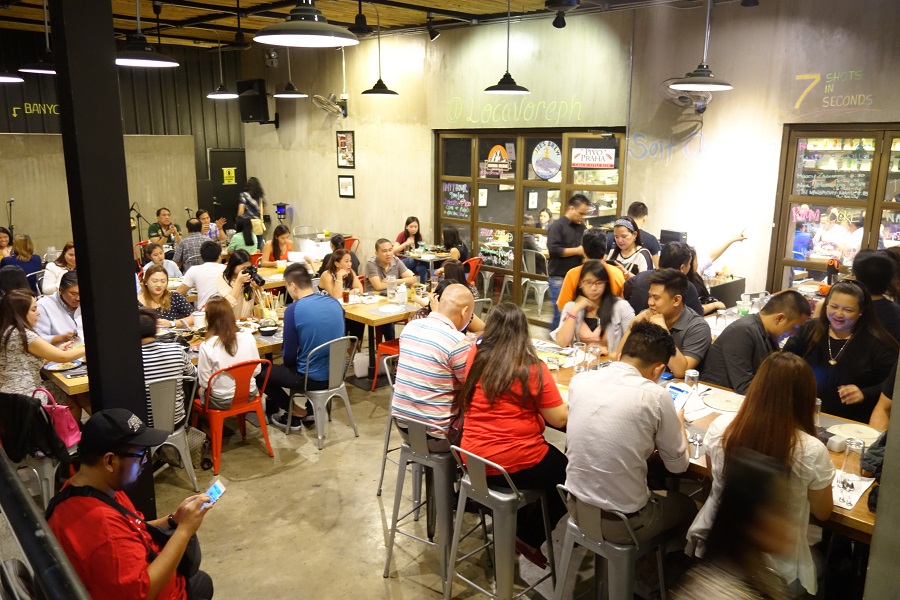
Last Tuesday, I was invited to try some of the blockbuster dishes at Locavore. I quickly forgot that I have a wedding gown to squeeze into less than 8 months from now and immediately accepted the invitation! Whenever I go to Locavore, I always order their bestseller, the Sizzling Sinigang, so I was excited to try the other much raved about eats at Locavore.
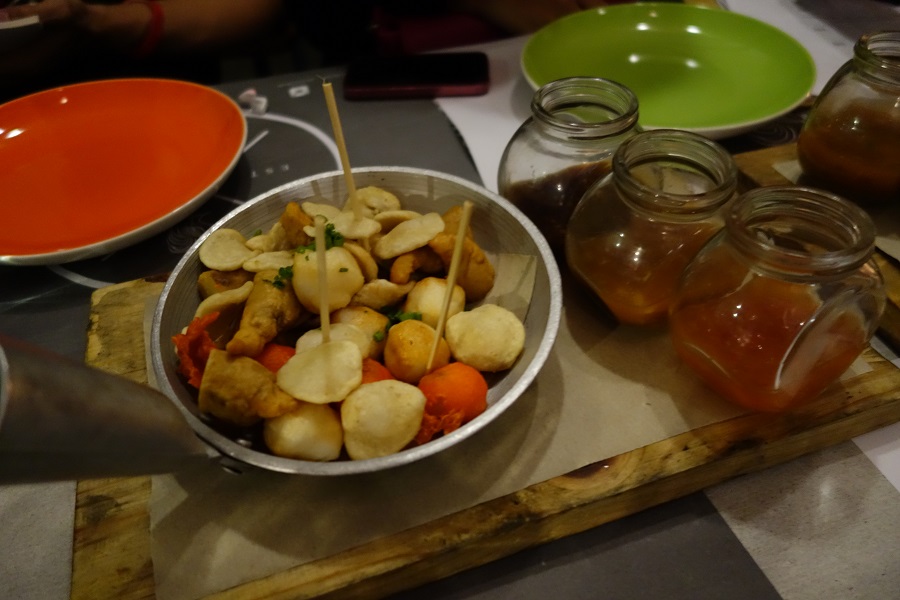
You know you’re a Filipino when you have, at least once in your life, tried one of these cheap-as-dirt, deep-fried snacks pushed around in mobile hawker carts. Locavore takes Filipinos back to their roots and lets foreign customers have a taste of the local street food scene by serving them with the Street Food Sampler, which is a small wok of fish balls (balls made from pulverized cuttlefish meat or Pollock), squid balls (balls made of squid puree), kikiam (ground pork and vegetables wrapped in bean curd sheets), and kwek-kwek (boiled quail eggs dipped in orange batter). You get to dip those nibbles in three kinds of sauces: Manong‘s sauce (Manong is a Filipino term usually used to address a man who is older than you), Sweet Chili, and Honey Vinegar. PHP 200 may be a steep price to pay for snacks that you can typically get for PHP 10-15 per stick, so save your money for the other must-not-miss main courses.
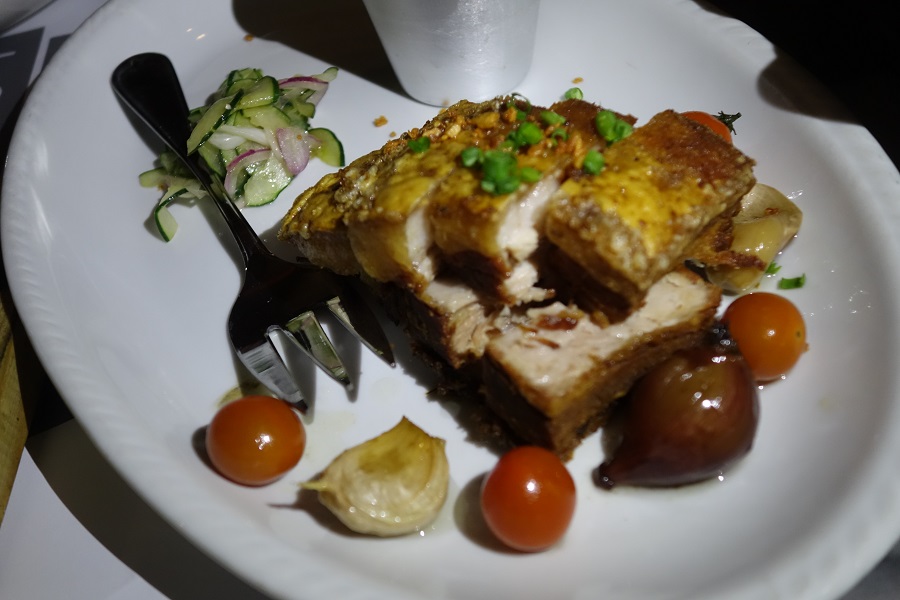
If you’re going to indulge in a guilty pleasure, Locavore’s Boneless Lechon Belly can give you that sinful satisfaction. Bite into the tender meat of this Cebu Lechon, let the fat melt in your mouth, and cap off the belly binge with the crunchy skin. It’s served with pinakurat (a kind of spiced vinegar), bagoong dipping sauce (shrimp paste), pickled red onion, and cucumber. It takes 24 hours for this dish to be prepared, but it will only take you 10 minute to finish it off!
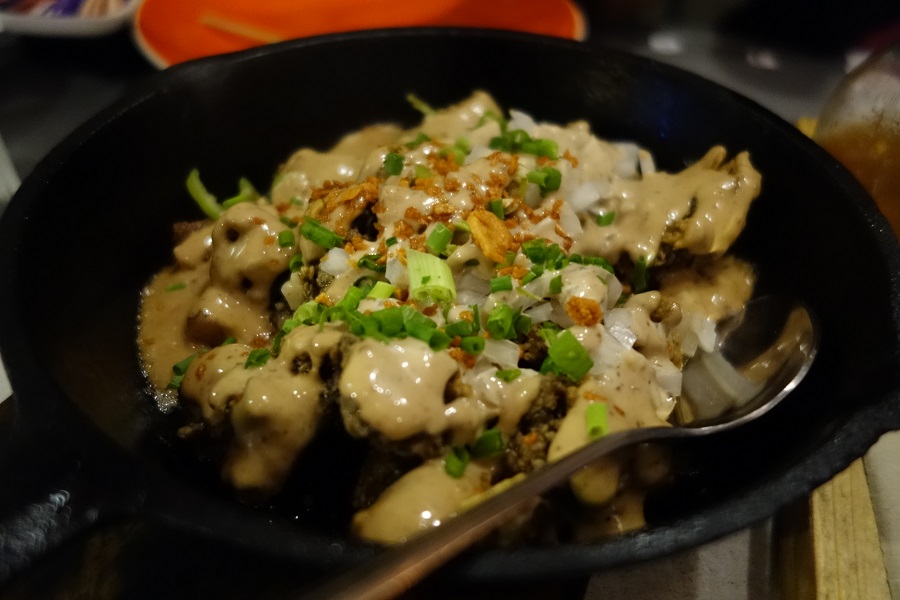
I don’t like oysters. Despite its reputation as a powerful aphrodisiac (oooh!), I was never really fond of it. We were seated in a dark area of the restaurant during the food tasting event, with only a small candle as our only source of light, so I couldn’t really see what I was eating. I couldn’t tell what the dish was made of, except by guessing the ingredients, using nothing but my taste buds. Well, I could not have guessed that this was Fried Oyster Sisig. First of all, I could not even have guessed that there were oysters in it. Second, who makes sisig with oysters?! No one! I think I tasted a bit of liver (another dish I don’t like, which, surprisingly, tasted good), some mayonnaise, garlic, and of course, crunchy pork. I’ve tried many sisig dishes, and they all taste the same to me. This one was creamy and full-flavored, and hands down, one of the most distinct sisig dishes I’ve tried.
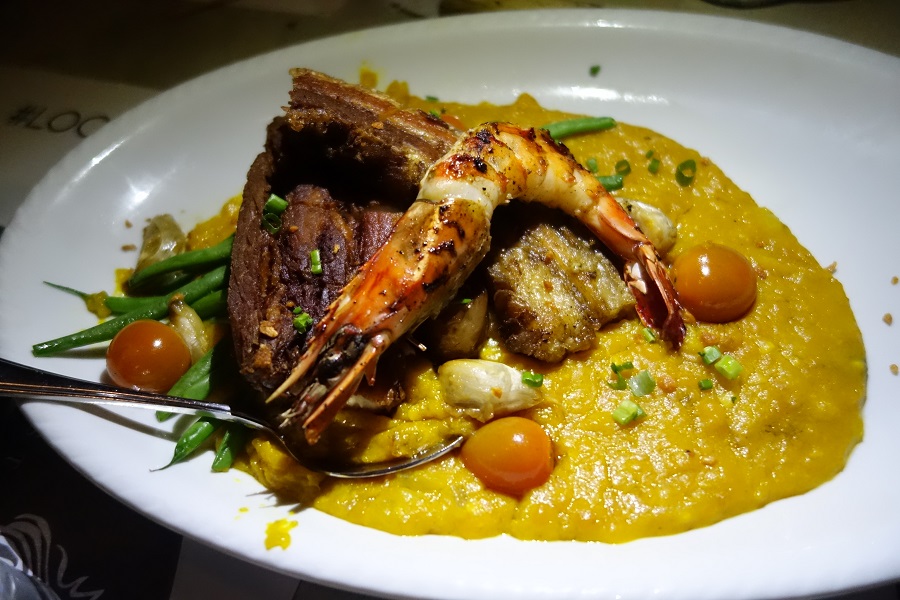
Locavore may be a carnivore’s lair, but vegetarians need not feel out of place. While their menu is mostly meat-based, they do have a few vegetarian dishes, as well as courses that make good use of veggies, such as the Ginataang Kalabasa. Ginataan is a Filipino term for “food that is cooked with gata (coconut milk)” while kalabasa is “winter squash,” similar to a pumpkin. It may look like baby food, but don’t underestimate the squash. One spoonful of this smooth and delectable stuff, and you could find yourself licking your plate clean. Even without the porkchop and the shrimp, I would have been satisfied with just the squash, as well as the cherry tomatoes and French beans. Why should the meat-eaters have all the fun?
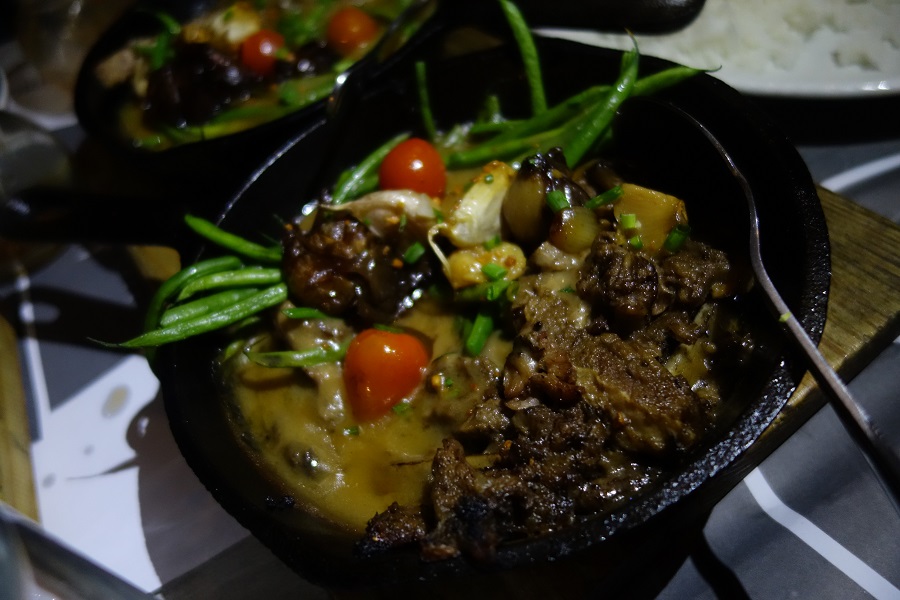
The Sizzling Sinigang is one rebel of a dish. It’s still your good old Filipino comfort food, but it’s the kind of sinigang that breaks the rules and challenges what people are used to. Chef Kel told us the story of how the Sizzling Sinigang came to be:
The inspiration came from our family. Our family’s sinigang is made of thick soup because my dad mashes the gabi (taro). This dish is actually an accident. On our opening night, my assistant chef did not order the ingredients that I needed, so I did not know what I was going to serve that night. The beef that he ordered were kalbi beef cuts, [which was not what I wanted.] So I said, ‘Okay, let’s just cook the sinigang.’ People actually liked it!
All’s well that ends well, after all, because the Sizzling Sinigang turned out to be Locavore’s bestseller! By nature, each and every component of the sinigang is still there — it still contains tamarind broth, it uses fresh beans as a substitute for string beans, cherry tomatoes take the place of regular tomatoes, roasted garlic and salad confit are an alternative to just the usual onion and garlic, and of course, there’s the beef. It’s sinigang, all right, but it’s sinigang on a class of its own. And just so you know, it takes the kitchen staff of Locavore 6 hours to prepare this, so please, enjoy every single morsel of it. That shouldn’t be too hard!
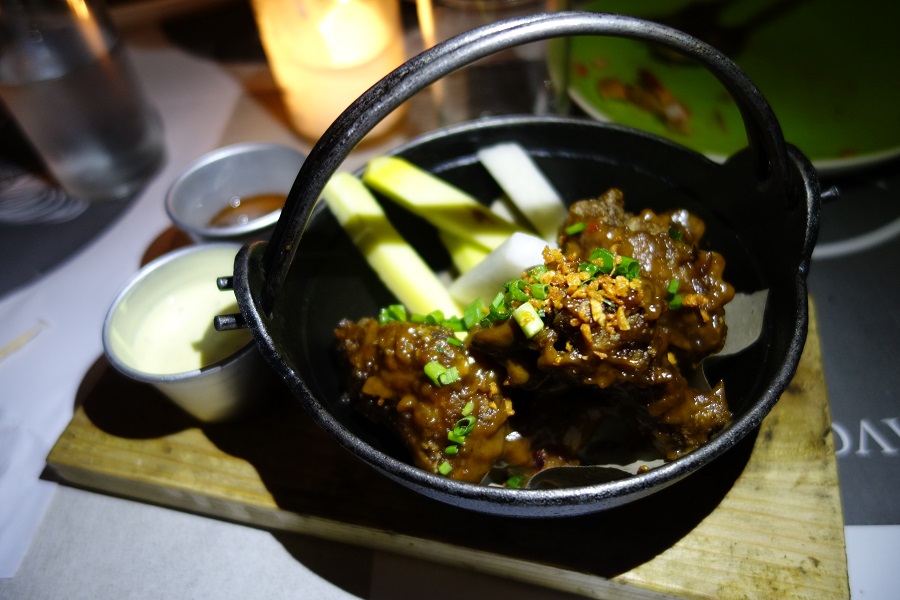
This is a new dish in the menu. Chef Kel’s friends were teasing him about Locavore not having kare kare (Filipino stew made with peanut sauce) in their menu, given that it is a Filipino restaurant. Kare kare is a staple in most, if not all Filipino restaurants! Chef Kel thought long and hard about creating a unique kare kare dish because he didn’t want to serve the dish the usual way (you should know by now that “usual” is not in Locavore’s vocabulary). Since Locavore is a gastropub, he thought of creating an appetizer that is best eaten while drinking liquor, and that is the Kare Kare Wings — fried chicken wings with kare kare glaze, turnips and green mangoes (as a substitute for carrots and celery crudités), bagoong (shrimp paste), and ranch sauce. Well, what do you know?! It really did taste a lot like kare kare, but in the form of chicken wings! It had the distinct peanut taste you would find in kare kare, so it’s sweet and salty at the same time. They’re really crunchy too. Interesting!
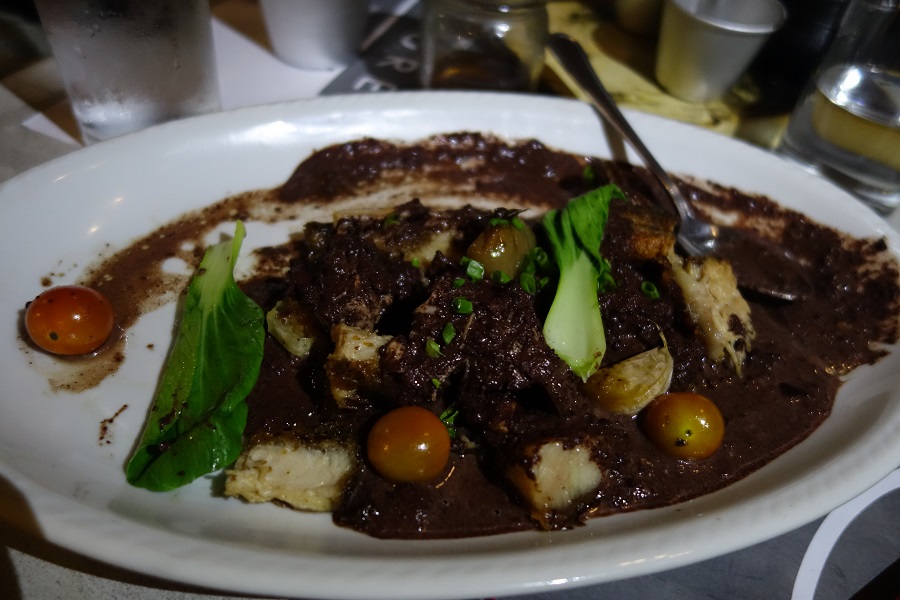
For those of you who don’t know what “that black sauce” is, I’m not going to sugar coat this: dinuguan is a stew of meat and offal simmered in a sauce made of pig blood. (“Dinuguan” comes from the root word “dugo,” which means “blood”), I know killing a pig is savage enough, and drinking its blood is even more brutal, but Filipinos just won’t let good blood go to waste! I’m not really a fan of dinuguan so I only tried a small piece but I thought it was good anyway. I must say, this is an interesting take on the popular Filipino viand. Who thought that you can combine dinuguan with lechon, bok choy, garlic confit, and cherry tomatoes? The mix of all these ingredients is… bloody brilliant!
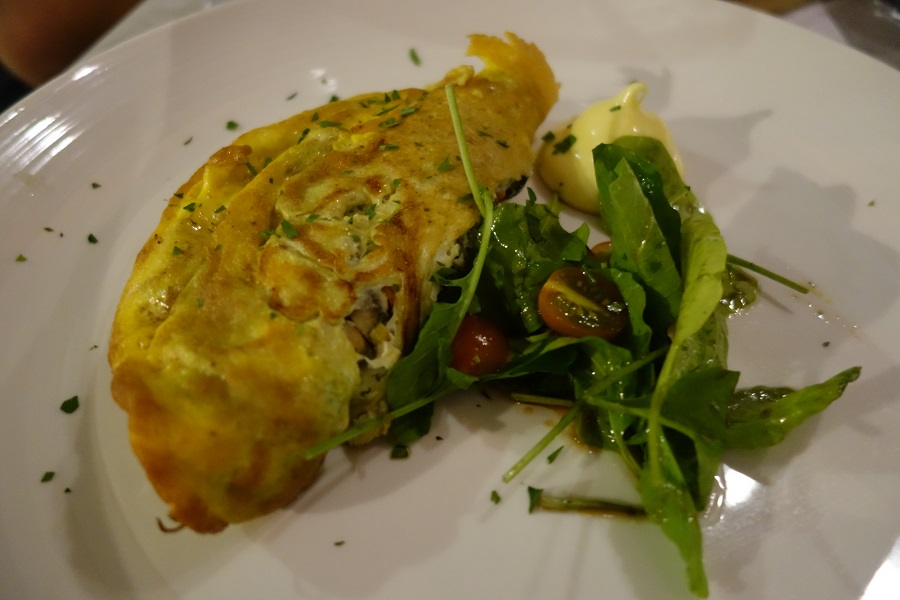
When the waiter put down the plate of the Tortang Talaba (oyster omelette) in front of us, I thought it seemed odd that they would serve us breakfast food at 10:00 at night, and an omelette isn’t something I normally see in a pub. But when I had a bite of the dish, I didn’t care anymore what time of the day it was. This scramble of Kalibo oysters, mushrooms, togue (bean sprouts), spring onions, Japanese mayo, and arugula salad is something I wouldn’t mind having for breakfast, lunch, or dinner! It’s meaty and filling, yet light and healthy. And for someone who doesn’t like oysters to enjoy a dish made with oysters, that says something!
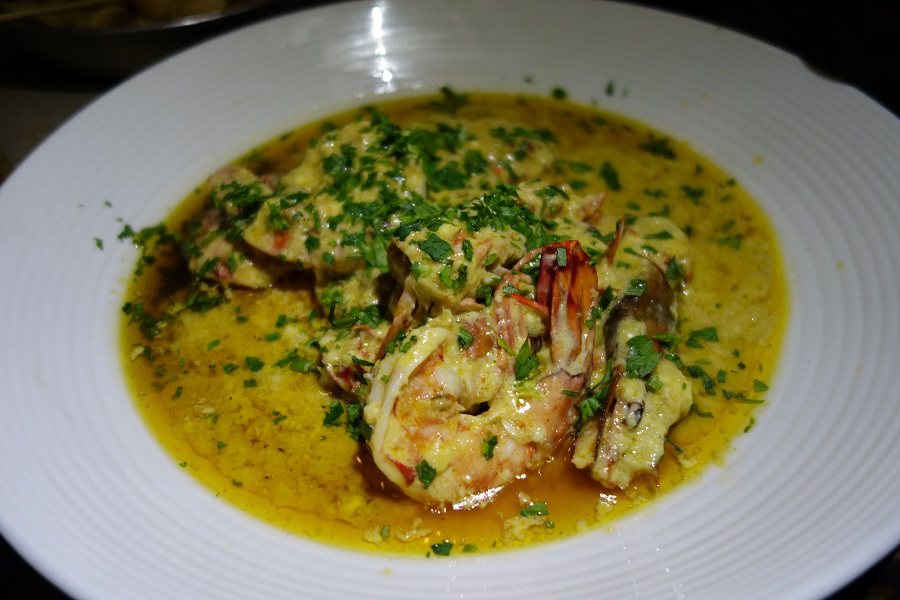
I saved the best main course for last! Just when I thought the Sizzling Sinigang was the best thing on the menu, here comes the Sugpo con Mayonesa — Jumbo black tiger prawns swimming in a sinfully savory sauce made of aligue (crab fat), garlic, butter, and Japanese mayonnaise. I bet you’re currently salivating just by looking at the picture. Well, wipe off that spittle off your chin and make your way to Locavore so you can indulge in this sensational seafood dish yourself. You think it looks delicious? Well, why look when you can taste? And yes, it is delicious.

So far, all of the savory dishes have been fantastic. But what about the desserts? We were served a plate of Torta Mangga, which is a cake made with mangoes, meringue, tablea (Filipino hot chocolate drink tablets made of dried pure cacao beans), and dulce de leche. It was big enough to be shared by two dessert-lovers. While it was okay, it wasn’t what I’d call a mind-blowing dessert. It was a little bland for me, except for the bits with the dulce de leche, which I liked a lot. It’s good for people who are not into desserts that are too sweet, but I think this one could have used just a little more sweetness. The mangoes that were used that night were not too sweet either. This cake has a lot of potential, though!
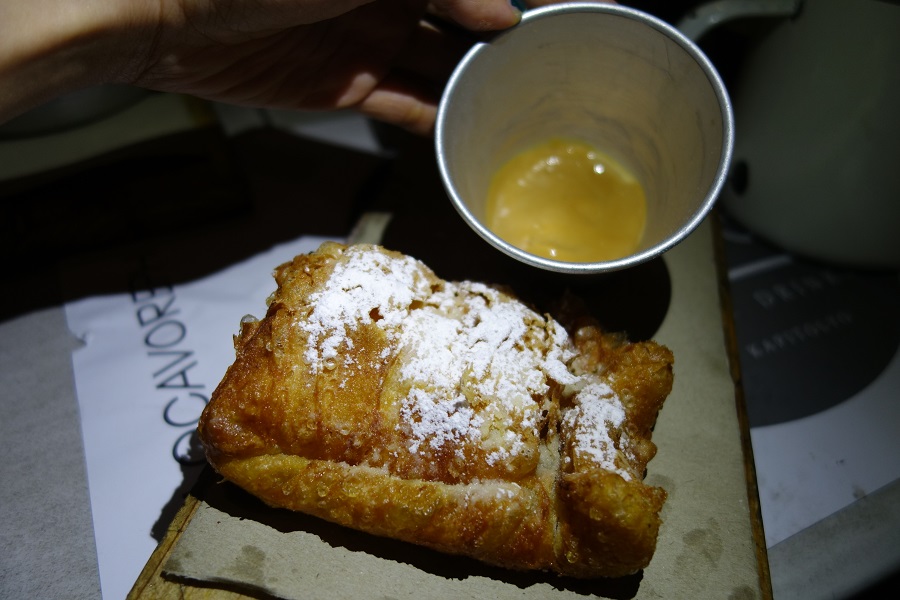
Turon is a popular street food/dessert which is usually banana and/or jackfruit enveloped in the same wrapper used for spring rolls, then deep fried and coated with hardened sugar. The Turon Con Leche is a different approach to the usual turon, because instead of using wrapping paper, it is made into a fluffy puff pastry stuffed with leche flan and salted egg. It comes with a dip of thick dulce de gatas (caramel spread made with carabao’s milk and brown sugar). The turon is fluffy and tastes more like sweetened bread than turon. I liked the dip so much that I would eat it on its own even without the pastry. It’s a nice mix of milky and sweet. TIf you like desserts that are simple, mildly sweet, and comforting, you might enjoy this.
Filipino food is one of those cuisines that are distinctive, and Locavore makes Filipino dishes even more extraordinary. But don’t mistake Locavore as a “fusion” restaurant because Chef Kel is against it, saying that it confuses people. Instead, Locavore applies the proper cooking techniques to their dishes and adds a little bit of twist to it, while still ensuring that the heart and soul of the dish is there. Locavore turns Filipino comfort food into a refreshing and exciting surprise!
What’s to like about Locavore:
- Awesome food
- Laid-back ambiance with great energy, perfect for when you want to have a few drinks and want to enjoy yummy food with your friends. (Not so ideal for intimate talks — the person at the next table will be able to hear everything!)
- Good music (there’s a band that plays at night)
- Wide selection of beers, wines, cocktails, and non-alcoholic beverages
- Perfect place to take your balikbayans (visitors / guests from foreign countries) when they’ve had Filipino food, like, 10 times during the last 5 days of their stay in Manila, and they’re already sick of sinigang, adobo, and whatnot. Here, they can have Filipino food that’s not like your ordinary Filipino food.
Not so loco about Locavore because of:
- The mosquitoes! I stayed in the second floor of the outdoor area, and the annoying mosquitoes were snacking on my legs as I was eating my food! Slather on some mosquito repellant if you’re planning to dine al fresco.
- Some inattentive waiters. They didn’t ask us for our drinks when we ordered, and we had to be the ones to call them again so they can get us our drinks. And then we asked for another candle (since the area we were in was dark), and the candle never came.
- The desserts. They’re all right, but nothing phenomenal, as compared to their main courses and appetizers, which are really good.
Locavore:
Address: 10 Brixton St. Kapitolyo, Pasig
Phone: (02) 632 9600
Mobile: (63 923) 5889419
E-mail: locavoreph@gmail.com
Website: http://www.locavore.ph/
Facebook: https://www.facebook.com/pages/Locavore-Kitchen-Drinks/400958036723741?fref=nf
Instagram: @locavore.ph
Hashtag: #Locavoreph
Photos by me

